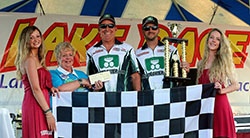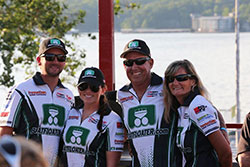Steve and Stephen Kildahl of Scott Free Racing Make Splash Racing Boats
- 22 juin 2016
Steve Kildahl, a resident of Sarasota, Florida, and owner of Central Marine Services, a boat repair shop in Sarasota, wanted to race boats with his brother Scott. So in 1985 he started to form a racing team. But before the formation of the team was complete, Scott was paralyzed and passed away soon after.
To honor his brother, Steve completed the creation of the racing team and called it Scott Free Racing and now he and his son Stephen race boats in Florida, Missouri, Michigan, Ohio, and Indiana. “My dad always had a passion for boats and boat racing. He’s been around boats his whole life,” explained Stephen, who lives in Ft. Myers, Florida and is the driver and vice president for Scott Free Racing, Inc. “After his brother died, he decided to name the team Scott Free Racing to acknowledge that Scott was free of all his disabilities.” So as Steve developed a reputation racing boats, Stephen, who is now 25, grew up around the marine repair shop and watching his dad race. It wasn’t long before the son had the same passion for boats as the father and he began to race boats himself when he was 10. “I raced a Mercury Water Mouse boat with the American Power Boat Association,” explained Stephen. “It gave kids a chance to get to know what offshore racing was like. “There were different types of boat racing including drag racing and kneel down race boats, but there wasn’t anything that catered to offshore racing. So Mercury formed this class, my dad supported and helped to promote it and I raced in it until I was 13.” After a couple years off from the sport, Stephen joined his dad. “We race a 30-foot Extreme in the Super Boat Vee Class,” continued Stephen. “It’s a canopy racing boat powered by a key single engine. It has a top speed of 95 mph and is very competitive.” He explained that teams in the class are permitted to build engines to specific specifications. “Still, the boats are pretty much the same. So it comes down to the skill of the person driving the boat as to who’s going to win,” he said. Races take place in oceans, lakes, and rivers. Half of the races the Kildahls compete in are in Florida, so races occur in the Atlantic Ocean and the Gulf of Mexico. The second half of the season is spent competing up north at such places as the St. Clair River in Michigan. About five to 10 boats compete in each event. Courses are arranged in a circle and can range from 4-1/2-miles to 5-miles in length. A race usually includes 12 laps for a total of 54 miles. “It’s like NASCAR on water,” said Stephen. There are two organizations that sanction events in which the Kildahls compete, Super Boat International, which sanctions most of their races in Florida; and the Offshore Powerboat Association (OPA), which sanctions the races in which the Kildahls compete in the north. Each organization presents seven to 12 races a year. To compete in the Super Boat International World Championships in Key West, Florida, you must compete in at least three Super Boat International events or you were the world champion the previous year. Both organizations have point standings, but the Kildahls compete only in the Super Boat International points competition. “We don’t compete in enough races to be in the OPA points standings,” said Stephen. The Super Boat International World Championships is the most important event for the Kildahls every year. “It is a week long event,” said Stephen. “Racers come down from all over the U.S. to compete and there are three different races, one each on Wednesday, Friday, and Sunday. Whoever gathers the most points out of those three days is the world champion.” Scott Free Racing has competed in the event for more than 32 years and has won three world championships, four national championships, and three Florida championships.
The boat has a crew of two. Stephen drives while his dad serves as throttle man. “There is a lot going on in the boat than what most people think,” explained Stephen. “The driver’s main responsibility is to steer the boat. The throttle man is responsible for the speed of the boat, control of its attitude, the propeller, and balance of the boat in rough conditions. The reason why there’s a crew of two is because it takes a lot to set up the boat when the waters are rough and the boat is flying in the air.” This year so far Scott Free Racing has competed in two races. Eight races remain on the schedule. In their first race in Cocoa Beach, Florida, the Kildahls suffered a mechanical failure, so they didn’t finish. They won their second race. In 2015 Scott Free Racing participated in five races. They won one and finished third in two of them. “The last race of the year was the World Championship in Key West. Another boat ran into us and damaged our boat’s canopy. It took us out of the event and it took most of the offseason to rebuild the boat.” Gary Armington re-constructed the fiberglass on the canopy on the boat. Stephen noted that they perform their own rigging and regularly test and maintain the boat. Innovation Marine, a local engine shop, maintains the boat’s engine. Preparing for a race includes studying and understanding the course. “Each course is different. So you have to know how many laps you have to run,” Stephen said.
In addition, they look over their notes from previous races at the location of an event. “We want to know what the water conditions were like, what set up we ran the last time, what props we ran, and where we placed the weights,” he said. “The boat has to weigh 4750 pounds after each race. So we have to add weight. We are allowed to distribute the weight any way we want,” he added. “We test a couple of set ups prop-wise and test all systems to make sure everything is functioning properly. “On the day of the race I want to make sure that I’m hydrated. It gets very hot on a race boat,” he added. K&N Engineering has sponsored Scott Free Racing for four years. Prior to that Stephen used K&N air filters when he raced as a kid and Steve has been using K&N products for more than 35 years. “We have run K&N filters on our motors ever since I can remember. There have been no failures and we’ve never used anything else,” said Stephen. Other Sponsors of Scott Free Racing include Boat Floater Industries, Champion Spark Plugs, Vostok Europe, Innovation Marine Corporation, Arrow RV, Pacer Group, Hydromotive Engineering, Custom Marine, and Hobby King. |
|||||
|
|||||












